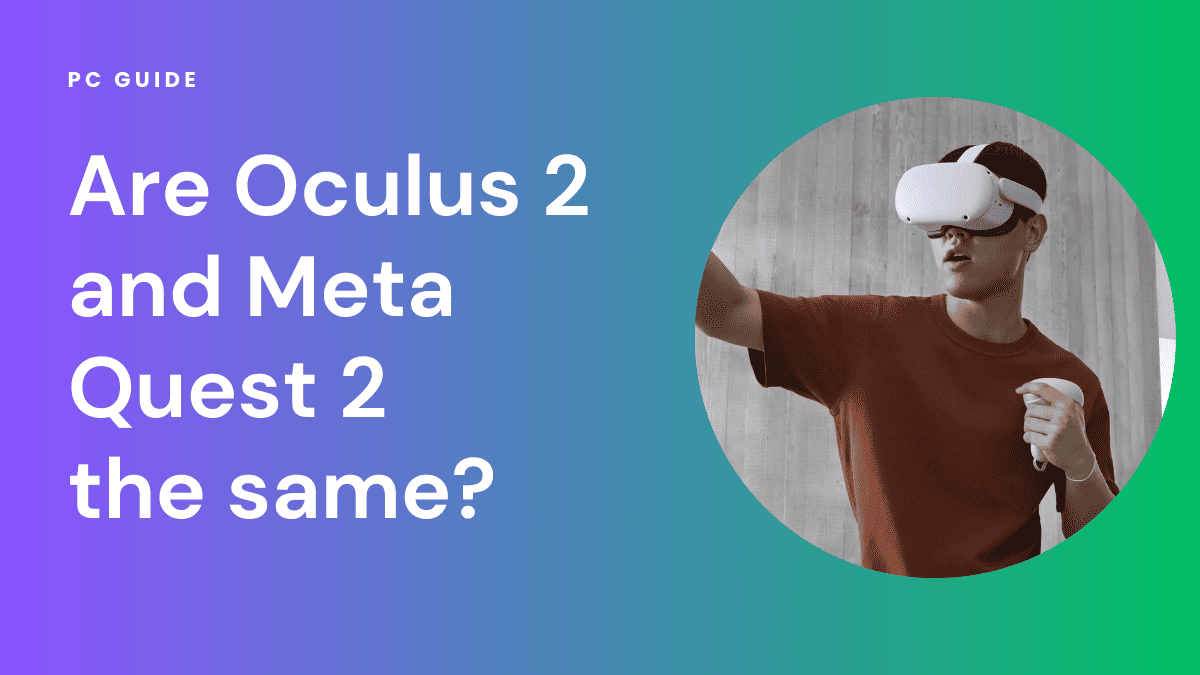Are Oculus 2 and Meta Quest 2 the same?

Table of Contents
The Oculus Quest 2 and Meta Quest 2 refer to the same virtual reality headset made by Meta. The name change from Oculus Quest 2 to Meta Quest 2 occurred in 2021 when Facebook rebranded itself as Meta. This caused some confusion among consumers whether Oculus Quest 2 and Meta Quest 2 were different products.
This article will clarify that they are, in fact, the same headset, just with two different names. Without any further ado, let’s begin!
Prime Day is finally here! Find all the biggest tech and PC deals below.
- Sapphire 11348-03-20G Pulse AMD Radeon™ RX 9070 XT Was $779 Now $739
- AMD Ryzen 7 7800X3D 8-Core, 16-Thread Desktop Processor Was $449 Now $341
- ASUS RTX™ 5060 OC Edition Graphics Card Was $379 Now $339
- LG 77-Inch Class OLED evo AI 4K C5 Series Smart TV Was $3,696 Now $2,796
- Intel® Core™ i7-14700K New Gaming Desktop Was $320.99 Now $274
- Lexar 2TB NM1090 w/HeatSink SSD PCIe Gen5x4 NVMe M.2 Was $281.97 Now $214.98
- Apple Watch Series 10 GPS + Cellular 42mm case Smartwatch Was $499.99 Now $379.99
- ASUS ROG Strix G16 (2025) 16" FHD, RTX 5060 gaming laptop Was $1,499.99 Now $1,274.99
- Apple iPad mini (A17 Pro): Apple Intelligence Was $499.99 Now $379.99
*Prices and savings subject to change. Click through to get the current prices.
The Rebranding: Oculus to Meta Quest 2
In October 2021, a significant shift occurred in the tech world when Facebook rebranded itself as Meta, signaling its commitment to building the metaverse. Alongside this monumental change, Oculus, Facebook’s VR arm, also underwent a transformation. The Oculus Quest 2 headset was rechristened as the Meta Quest 2.
However, it’s crucial to note that this name change was purely a rebranding strategy. The device’s hardware and specs remained untouched, aligning the VR products more closely with Meta’s new vision.
What’s in a Name?
To put it succinctly, the Oculus Quest 2 and the Meta Quest 2 are identical in terms of hardware and functionality. They are the same standalone VR headset, just marketed under different names due to the company’s rebranding.
Whether you purchased your device before or after the rebranding, it can be referred to as either one or the other.
Hardware specs
When it comes to hardware specifications, both versions of the Quest 2 are identical. They are powered by the Qualcomm Snapdragon XR2 Platform and come with 6GB of RAM. Storage options include either 128GB or 256GB. The device boasts a high-resolution display, offering 1832×1920, pixels per eye.
The fast-switching LCD and 3D positional audio enhance the immersive experience. Additionally, the touch controllers provide haptic feedback, elevating your VR gaming sessions.
Additional features and compatibility
Both versions of the Quest 2 come with inside-out tracking, eliminating the need for external cameras. The refresh rate is comfortable for extended use, and the battery life is robust enough for prolonged gaming or social media interactions. The device also supports hand tracking and is compatible with Android systems.
Logos and software: The only difference
The only discernible difference between these devices lies in the branding. The Oculus version will have Oculus logos and software, while the Meta version aligns with the new Meta branding.
However, this is purely aesthetic and does not affect the device’s performance or compatibility with PCs, Steam VR, or Wi-Fi.
Is upgrading necessary?
If you’re wondering whether any upgrades are available for the Meta Quest Pro or if you should expect changes in pixelization, lenses, or the Adreno GPU. Rest assured that both the Oculus and Meta versions are identical in these aspects as well.
Bluetooth connectivity remains standard, ensuring that your Quest 2, regardless of its branding, is a high-end, standalone VR headset capable of delivering a top-notch virtual experience.
By understanding these nuances, you can make an informed decision about your next VR purchase, whether it’s Oculus-branded or falls under the new Meta umbrella.
In summary: Unveiling the truth about Oculus 2 and Meta Quest 2
So, are Oculus 2 and Meta Quest 2 the same? The answer is a resounding yes. Both names refer to the same groundbreaking VR headset, with the Meta Quest 2 moniker emerging after Facebook’s transformation into Meta in 2021. Whether you’re browsing the Oculus store or exploring spatial computing experiences, rest assured that both versions offer identical functionality.
Whether you’re concerned about IPD (Interpupillary Distance) adjustments or intrigued by the color passthrough feature, both devices offer these capabilities. So, regardless of the name on the box, your VR experience will be as immersive and interactive as ever.
By understanding this, you can confidently make your next VR headset purchase, knowing that these two are indeed the same device, just branded differently.
